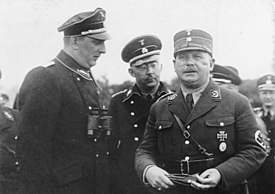
Back Nag van die lang messe Afrikaans ليلة السكاكين الطويلة Arabic Uzun bıçaqlar gecəsi Azerbaijani Ноч доўгіх нажоў Byelorussian Ноч доўгіх нажоў BE-X-OLD Нощ на дългите ножове Bulgarian Nozvezh an Hirgontilli Breton Nit dels ganivets llargs Catalan شەوی چەقۆ درێژەکان CKB Noc dlouhých nožů Czech
 Kurt Daluege, chief of the Ordnungspolizei; Heinrich Himmler, head of the SS; and Ernst Röhm, head of the SA, August 1933 | |
| Native name | Unternehmen Kolibri |
|---|---|
| Date | 30 June to 2 July 1934 (three days) |
| Location | Nazi Germany |
| Also known as | Operation Hummingbird, Röhm Putsch (by the Nazis), The Blood Purge |
| Type | Purge |
| Cause |
|
| Organised by | |
| Participants | |
| Outcome |
|
| Casualties | |
| Officially 85; estimates range up to 1,000.[1] | |
The Night of the Long Knives (German: ), also called the Röhm purge or Operation Hummingbird (German: Unternehmen Kolibri), was a purge that took place in Nazi Germany from 30 June to 2 July 1934. Chancellor Adolf Hitler, urged on by Hermann Göring and Heinrich Himmler, ordered a series of political extrajudicial executions intended to consolidate his power and alleviate the concerns of the German military about the role of Ernst Röhm and the Sturmabteilung (SA), the Nazis' paramilitary organization, known colloquially as "Brownshirts". Nazi propaganda presented the murders as a preventive measure against an alleged imminent coup by the SA under Röhm – the so-called Röhm Putsch.
The primary instruments of Hitler's action were the Schutzstaffel (SS) paramilitary force under Himmler and its Security Service (SD), and Gestapo (secret police) under Reinhard Heydrich, which between them carried out most of the killings. Göring's personal police battalion also took part. Many of those killed in the purge were leaders of the SA, the best-known being Röhm himself, the SA's chief of staff and one of Hitler's longtime supporters and allies. Leading members of the Strasserist faction of the Nazi Party, including its leader Gregor Strasser, were also killed, as were establishment conservatives and anti-Nazis, such as former Chancellor Kurt von Schleicher and Bavarian politician Gustav Ritter von Kahr, who had helped suppress Hitler's Munich Beer Hall Putsch in 1923. The murders of SA leaders were also intended to improve the image of the Hitler government with a German public that was increasingly critical of thuggish SA tactics.
Hitler saw the independence of the SA and the penchant of its members for street violence as a direct threat to his newly gained political power. He also wanted to appease leaders of the Reichswehr, the German military, who feared and despised the SA as a potential rival, in particular because of Röhm's ambition to merge the army and the SA under his own leadership. Additionally, Hitler was uncomfortable with Röhm's outspoken support for a "second revolution" to redistribute wealth. In Röhm's view, President Paul von Hindenburg's appointment of Hitler as chancellor on 30 January 1933 had brought the Nazi Party to power, but had left unfulfilled the party's larger goals. Finally, Hitler used the purge to attack or eliminate German critics of his new regime, especially those loyal to Vice-Chancellor Franz von Papen, as well as to settle scores with enemies.[a]
At least 85 people died during the purge, although the final death toll may have been in the hundreds,[b][c][d] with high estimates running from 700 to 1,000.[1] More than 1,000 perceived opponents were arrested.[2] The purge strengthened and consolidated the support of the military for Hitler. It also provided a legal grounding for the Nazis, as the German courts and cabinet quickly swept aside centuries of legal prohibition against extrajudicial killings to demonstrate their loyalty to the regime. The Night of the Long Knives was a turning point for the German government.[3] It established Hitler as the supreme administrator of justice of the German people, as he put it in his 13 July speech to the Reichstag.
- ^ a b Larson, Erik (2011). In the Garden of Beasts. New York: Broadway Paperbacks. p. 314. ISBN 978-0-307-40885-3.
citing:
– memoranda in the W. E. Dodd papers;
– Wheeler-Bennett, John W. (1953) The Nemesis of Power: The German Army in Politics 1918–1945, London: Macmillan p. 323;
– Gallo, Max (1972) The Night of the Long Knives New York: Harper & Row, pp. 256, 258;
– Rürup, Reinhard (ed.) (1996) Topography of Terror: SS, Gestapo and Reichssichherheitshauptamt on the "Prinz-Albrecht-Terrain", A Documentation Berlin: Verlag Willmuth Arenhovel, pp. 53, 223;
– Kershaw Hubris p. 515;
– Evans (2005), pp. 34–36;
– Strasser, Otto and Stern, Michael (1943) Flight from Terror New York: Robert M. McBride, pp. 252, 263;
– Gisevius, Hans Bernd (1947) To the Bitter End New York: Houghton Mifflin, p. 153;
– Metcalfe, Phillip (1988) 1933 Sag Harbor, New York: Permanent Press, p. 269 - ^ Evans 2005, p. 39.
- ^ Johnson 1991, pp. 298–299.
Cite error: There are <ref group=lower-alpha> tags or {{efn}} templates on this page, but the references will not show without a {{reflist|group=lower-alpha}} template or {{notelist}} template (see the help page).